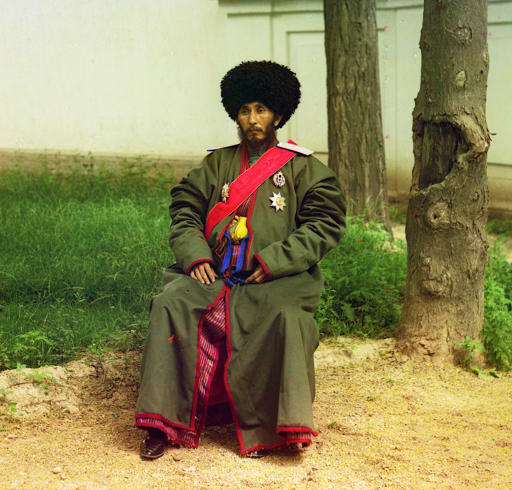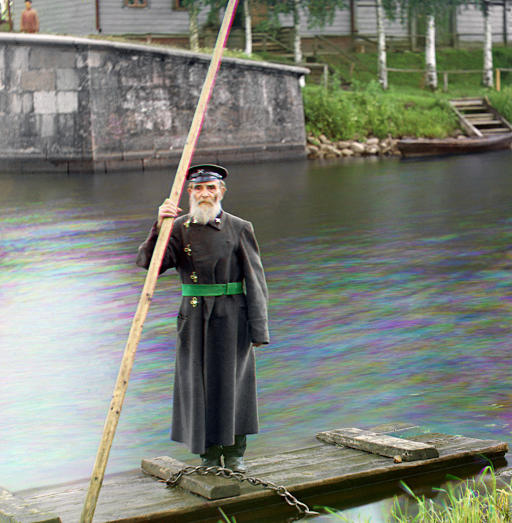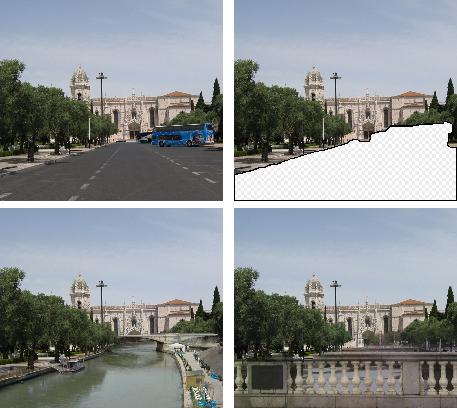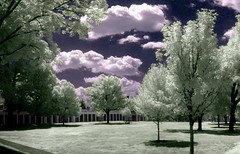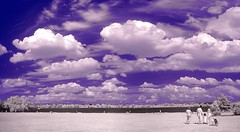The Null Device
Posts matching tags 'photography'
2010/11/27
The Graun has a piece on post-punk photographer turned film director Anton Corbijn, whose second film, The American (a film entirely unrelated to post-punk, rock music or that entire stream of monochromatic cool Corbijn is associated with) is coming out soon:
I didn't really know how to make a film when I made Control. I had to create my own language, just as I did when I started taking photographs. I never studied either one." But surely clueless film directors don't win prizes at Cannes? "True, but film-making is extreme for me. I can't use lights. I need others to help me to put shots together. Directing film is the hardest thing I have ever done." Even though you directed more than 100 rock videos? "I know just enough not to look stupid. Mostly that means I know who to ask."
He became a performer, emulating the great photographic artist Cindy Sherman. He got made up, put himself on the other side of the camera and shot himself in bleak Dutch settings disguised as a series of dead musicians – John Lennon, Jimi Hendrix, Sid Vicious, Elvis, Frank Zappa. The resulting book was a revealing document about his obsessions. "I guess I always wanted to be 'a somebody', and I only admitted this to myself in my 40s," he said. One of the happiest moments in his professional life, he says, was when Depeche Mode's drummer couldn't make it to the Top of the Pops studio so Corbijn (an amateur drummer) stepped in and was paid by the BBC for his performance.
2010/11/24
Another place not to visit: Kuwait has banned the use of DSLR cameras in public places except by registered journalists. Compact cameras are exempt from the ban, presumably because banning them would have involved banning most mobile phones.
Restrictions on photography aren't unprecedented for Middle Eastern monarchies. In the United Arab Emirates (which includes Dubai, one of the region's more liberal enclaves), for example, photo-sharing site Flickr is blocked.
2010/10/4
Facebook has just upgraded its photo sharing feature, increasing the maximum dimension along either axis from a miserly 720 pixels to 2,048 pixels, improving tagging and adding a lightbox interface. Some are saying that the upgrade poises Facebook to challenge Flickr as a serious photo sharing site (Facebook already hosts more than three times as many photos as Flickr does); however, the fact remains that photographs on Facebook still have a distinctive "Facebook style":
(The Facebook Style is not to be confused with the MySpace Angle, though it's presumably possible for a photograph to meet the definitions of both.)A few days ago I ran into one of my nieces whom I hadn't seen for a while. She's a lively, sociable young woman and had recently returned from spending an enjoyable summer in Cape Cod. I asked if she had any photographs. "Sure," she said, launching her Facebook page, where there was an album of 150 images, which on inspection turned out to be a succession of more or less identical images of young men and women wearing silly grins and making faces at the camera.
Two things struck me about this album. The first was that it contained not a single image of Cape Cod. The other was how her photographs reminded me of those which appear on the Facebook pages of my own teenage children – which leads one to conjecture that there is now a "Facebook style" of photography, as distinctive in its way as that of the passport or wedding photograph.
Among Facebook's 15bn photographs there are, no doubt, some memorable and beautiful images, but to date I haven't seen any. That's not true of Flickr, which continues to be one of the wonders of the world and hosts hundreds of thousands of terrific pictures. More significantly, an increasing proportion of them are published under a Creative Commons licence, which means that they can be freely used for non-commercial purposes.
In any case, while Facebook's photo sharing tools may be improved, it is unlikely to become a Flickr-killing platform for strikingly beautiful photographs, for reasons of culture and function. Facebook is, after all, primarily a social site; its strengths come from the ability to share things meaningful to one's friends, which would be tediously mundane or irrelevant to anybody else. Few people are interested in identical mugshots of strangers gurning at the camera in pubs or backyards, though the family members and chums of the gurners in question probably are.
Flickr, meanwhile, is a site for publishing photographs, where the photographs are the primary focus. It has social features (users can favourite or comment on photos with their pseudonymous Flickr account IDs, and add other information about themselves), but they are secondary to the application of showing photographs. To wit, Flickr not only has keyword tags but also groups, with themes such as "sunsets", "wide-angle photos", "things which are red", or "Paris", where users can send their photos, making them available for viewing by strangers who share an interest in their theme. This is not something Facebook is good at. (Mind you, it goes both ways; Flickr recently added the ability to tag other Flickr users in photos, though that doesn't seem as useful as Facebook's person-tagging feature; unless one hangs out only with keen photographers, one's friends are unlikely to be on Flickr.) I don't think Facebook is going to eat Flickr's lunch any time soon. (Nor, for that matter, is Google's Picasa, nor any of the Flickr-alikes like Zooomr or Ipernity.)
And while we're on the subject of beautiful photos on Flickr, Ffffl*ckr is a new web-based tool which, given access to your Flickr account, will find other photos you are likely to like, by looking at photos your favourited and seeing what their takers favourited.
2010/8/27
The Boston Globe has posted a selection of colour photographs taken across the Russian empire around 1910. The photographer, Sergei Mikhailovich Prokudin-Gorskii, travelled the length and breadth of Russia and its holdings (some of which are now in places like Georgia and even Turkey) at the Tsar's behest, producing a comprehensive photographic survey. Of course, colour film had yet to be invented, so Prudkin-Gorskii took his photos by taking three exposures, each with a different coloured filter in front of the lens, using a specialised camera that allowed for the filters to be swapped quickly. (It's not unlike the technique used to take HDR photos these days.) Anyway, the original glass plates were bought by the US Library of Congress in 1948 (not sure from whom; perhaps a White Russian exile took them whilst fleeing the Bolsheviks and they spent three decades in a suitcase in Paris or somewhere?), and have since been composited together into stunning full-colour images of what we too often think of as a sepia-toned age:
2010/8/11
The latest instalment of the OKCupid team's data-mining project looks at the correlations between the attractiveness of profile pictures attractiveness and the EXIF metadata contained in them. Among other things, it has found that:
- While a better camera may not make you a better photographer, it will make you look sexier (assuming you're being photographed with it, that is). Photos taken with Micro Four-Thirds cameras looked the best, followed by those taken with DSLRs, then compacts and finally camera phones, with Windows and Motorola phones taking the most minging profile pictures.
- Apple products do get you laid. or at least iPhone users have richer love lives than users of other smartphones.
- If you wish to take a flattering photo, open the aperture, getting a nice short depth of field (having a good camera, or at least not a cameraphone, helps here) and, for God's sake, don't use flash. (Unless perhaps you're going for that abject hipster porn aesthetic you see in American Apparel ads and Terry Richardson features in Vice.)
- The golden hour is not a myth; attractiveness of photos does spike immediately after sunrise and before sunset.
2010/7/1
The latest compact camera from Samsung, until now a brand more associated with cheap consumer units, looks interesting. The Samsung EX1 seems to be targetted at the niche at the top end of the compact market currently held by Panasonic's DMC-LX3; it has the solid metal body and large image sensor (1/1.7", with only 10 megapixels), and trumps the LX3 by having a f/1.8 lens (to the LX3's f/2.0, to say nothing of Canon's G11, the lowly f/2.8 aperture of whose lens borders on insulting), a fold-out screen (just like the PowerShot G series had back when it was good, only this one's AMOLED). It doesn't have the LX3's range of manual controls (the aspect-ratio and focus mode switches on the lens barrel), and appears to have fewer aspect ratio options, but the quality is said to outperform the LX3.
2010/6/2
Monocle magazine has a video report on The Impossible Project the (successful) recent project to develop and manufacture new film for Polaroid cameras, keeping the world's hipsters in instant film for the foreseeable future.
2010/3/19
Two artists in Berlin have created a digital camera which automatically edits smiles onto the subjects:

The camera „Artificial Smile“ is an apparat, whose pictures show in principle only smiling people, irrespective of their former emotional state. The camera uses a pool of pictures with smiling faces, which was created beforehand, to replace the mouthes of the pictured people with smiling ones. To generate to maximum level of exaggeration it was knowingly renounced to show the laughter/smile realistically. Unlike the cameras commercially available on the market and their autoretouch function “Artificial Smile” distorts the context of the picture, reinforced formally by the golden reflecting body of the camera.
2009/9/23
As September 2009 comes to an end, so (arguably) does an era of sorts, because that is when the last batch of Polaroid film expires. Cue the standard nostalgia for the "authenticity" of lossy, pre-digital technologies:
More significantly, though less obviously, it's the end of an era because Polaroid photography was the last technology of irreproducibility. In the digital age we expect – we assume – that every data-based artefact is infinitely reproducible. A piece of recorded music can be ripped, burned, stretched, transposed, copied, compressed and shared to our heart's content. The same goes for video. In writing, there are no longer manuscripts, only versions of files which can be edited, printed, saved (as .doc, RTF, plain text, PDF or XML, all representing the same piece of work). Photography developed rapidly into something similar, and did it first: as soon as the photographic negative arrived on the scene, photography incorporated the idea of the "original" which could be used to make multiple copies. But only the first copy, the print made from the original negative, was of the highest grade. Every generation of copy thereafter deteriorated; information was lost every time a new copy was made. Nor was any copy, any print, definitive. Anyone who has worked in a darkroom knows you can make 20 prints from one negative and every one will be slightly different, depending on the enlarger, the exposure, the manipulation, the developer, the paper, the temperature.The article goes on to mention instant photography's place in the history of 20th-century sexual morés:
Which was, of course, another driving force behind Polaroid: no trip down to the chemist. As one commenter on The New York Times Lede blog wrote: "I bought a Polaroid circa 1986, the day I got a short note from my corner drugstore, 'Dear customer, We are returning your negatives. We regret the inconvenience, but Walgreens does not print photos from negatives of that nature.'" How many marriages did the discreet Polaroid save? How many did it undo? How many secret passions did the unmistakable clunky click WHIRRRRR document? In Britain we weren't allowed to buy the radio remote control "because of RF interference", but I suspected it was the same thinking that undid Oscar Wilde: people should under no circumstances be allowed to do what they like in their bedrooms. Phoo to that. I brought a remote control back from New York and you probably did too.Art hipsters and retro perverts need not despair, however, as long as these people can succeed in making Polaroid-style instant film.
2009/8/20
Nine years ago, Canon released the PowerShot G1, a premium compact digital camera, kicking off the G series. The G cameras had fold-out screens, fast f/2.0 lenses and excellent dynamic range and low-light performance. Then, in 2006, it all started to go pear-shaped; with the G7, Canon downgraded the line to a weightier version of the consumer A series; the size was reduced, the fold-out LCD was gone, and the f/2.0 lens was replaced with a slower f/2.8 lens, of the sort typically found in consumer cameras. Meanwhile, Canon cranked up the megapixels, cramming increasing numbers of pixels into the small sensor, resulting in inevitable compromises to dynamic range and low-light performance (the latter not helped by the lens). While Canon still had their historic name to impress those who didn't look too hard, newcomers stole a march on them in the compact market; not least among them Panasonic, with the Lumix DMC-LX3.
Now it seems that Canon have seen the light and are moving back in the right direction; they just announced the PowerShot G11. The successor to the G10, it knocks down the pixel count from 14 megapixels to an altogether more reasonable 10, and reinstates the fold-out screen. However, the f/2.8 lens stays.
Which is a good start, though it'd take a lot more for me to buy a PowerShot again. I've had a DMC-LX3 since the end of last year, and have been somewhat spoiled by it: by the image quality, which is superb for a compact, the fast f/2.0 lens, and by other enhancements which are wholly innovative; the user interface, for example, consists not only of the usual MENU button and D-pad, but includes dedicated switches for focus mode and aspect ratio. (Which brings me to another feature: you can change the aspect ratio between TV (4:3, as in most compacts), 35mm film (3:2, as in most DSLRs) and widescreen (16:9) to suit your compositions.) If you push the joystick in, a pulldown menu appears, giving you quick access to common settings such as resolution and ISO mode. Cranking the resolution down gives you a nonmagnifying digital zoom, letting you zoom beyond the lens's (admittedly middling) range by cropping to the centre of the image without blowing things up as the "digital zoom" in other cameras does. The USB interface looks like a mass storage device one can copy image files from. It's little grace notes like these which make a better camera.
While Canon were away (and they were, for about three years), Panasonic came up and ate their lunch. While the G11 is a welcome first step, it'll take a lot more than that for the G series to regain its leading position.
2009/7/17
The latest innovation in digital photography: the "dark flash", which allows the benefits of flash photography, such as short exposures, without the glare.
The dark flash works by modifying a camera's flash to emit only infrared and ultraviolet light, and capturing a crisp, if discoloured, image using these, as well as a less distinct but properly coloured image without flash, and compositing the two into a single image.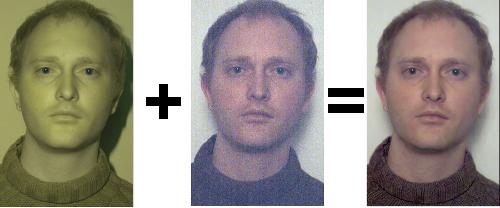
2009/4/21
Der Spiegel has some evocative photographs from East Germany, taken by West German photographer Karlheinz Jardner in 1990, not long after the wall came down. It includes shots of room interiors frozen in the perpetual 1970s of the DDR, dilapidated provincial cities with Trabants, more Trabants, luxury hotels reserved for the Communist Party elite, dilapidated seaside resorts, cheerful urchins with piles of coal, uninspiring consumer goods and symphonies of grey; some glimpses of a parallel world, just before it disappeared.
And here is a Fortean Times piece on "The Ghosts of East Berlin".
2008/11/12
The Independent talks to the kid who was the baby on the cover of Nirvana's Nevermind. He is Spencer Elden, now 17; his parents were paid $200 for the photo in 1991, though he has since had other record cover work, and has recently recreated the cover, this time wearing shorts.
Spencer, for his part, says the record helped bring about a typically choppy adolescence. He grew up with a platinum copy of Nevermind hanging on his bedroom wall and once confessed, in moments of hormonal frustration, to using the chat-up line "You want to see my penis again?" at teenage discos.
Last year, he was sent to a military boarding school to correct what his parents have described as a tendency to test authority. He's now hoping to either enrol at West Point Military Academy, or a local art school.
2008/9/3
In December 1969, a young man from the south of England decided, under the influence of kitchen-sink films, to go to the North with his camera and capture the stark beauty of the old North on film before it disappeared forever. Some decades later, he got a Flickr account, scanned his photos and posted them here. Most of them are in black and white, and many are quite beautiful, in a somewhat bleak, sparse sort of way.
The photographs, which are generally beautifully shot, are accompanied by the photographer's descriptions of the scenes, in which he laments the passing of the old grim north, and the Southernisation of England, with the arrival of things such as pebbledash, holidays to Florida and even the Clean Air Act. Which does at times seem somewhat problematic; I suspect that the residents of Moss Side or St. Helens would quite happily sacrifice the bleak poignancy of their streetscapes for holidays in the sun and indoor lavatories (not to mention not dying prematurely from the effects of air pollution), though other pieces (such as this one about lost opportunities for childrens' play and this lengthy meditation on fleeting experience and the beauty in the mundane are simply sublime.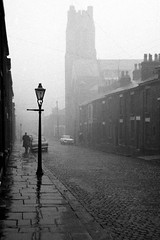



2008/8/25
Canon have announced the next crop of PowerShot cameras, at least in the A and S series. As expected, they're still running the megapixel race hard, cramming more and more increasingly tiny pixels into a pocket-sized sensor to give the public excitingly bigger numbers, whilst ignoring the growing chorus of criticism that more pixels aren't better. So when you buy one and realise that your new 10-megapixel photos look like crap compared to the old A570IS you just replaced (which didn't look that crash hot when compared to the silky-smooth dynamic range from your ancient 4MP PowerShot G2), you'll know why, and wish you had gone and bought a camera with fewer pixels. Well, if they actually still made them, that is.
You can blame the gullible idiots who are convinced that more pixels is better, have no idea of esoteric concepts such as "noise" or "dynamic range", and will rush out to buy anything with a higher pixel count, dooming any compact camera with fewer, decent-sized pixels to certain death in the marketplace. Though you'd think that there'd be enough people with a clue and a demand for a high-quality pocket-sized camera with the right compromises made in its design parameters to give the best (as opposed to biggest) images you can expect from that size, for Canon (or someone) to bother making such a line.
2008/7/30
Researchers at Columbia University have developed a new system for protecting the privacy of people who appear in photographs. Rather than blurring or erasing faces, the new software replaces facial features with others from a library:

The software randomly selects 33,000 photos of faces from picture-sharing sites like Flickr.com, then picks the most suitable faces for each person in shot. Only the eyes, nose and mouth are used, resulting in a composite image of the two people. "It matches subject pose, lighting conditions and image resolution," says Kumar. "The selected faces are aligned to common 3D coordinates, corrected for colour and lighting, and blended into the target image."
Aside from Street View, the system could be used to obscure the faces of military personnel or eyewitnesses to crime. It could also allow amateur photographers to improve group shots, by replacing frowning faces with better photos of the same people.
(via Boing Boing) ¶ 0
2008/7/12
Recently I was going through some photos I took, on my Mac, and found that they all looked a bit blurry; none of them, I thought disappointedly, had turned out well enough to post to Flickr, and my photographic expedition had been for naught. A while later, I looked through them on my Linux box, using eog, and was surprised to find that they looked much crisper, and some of them had come out quite well. Which suggests to me that OSX 10.5's Preview has a bug in it, which causes images to be blurred.
Some evidence: here is a photograph, as shown in OSX using Preview:
And here is the same image, as viewed using eog on Linux: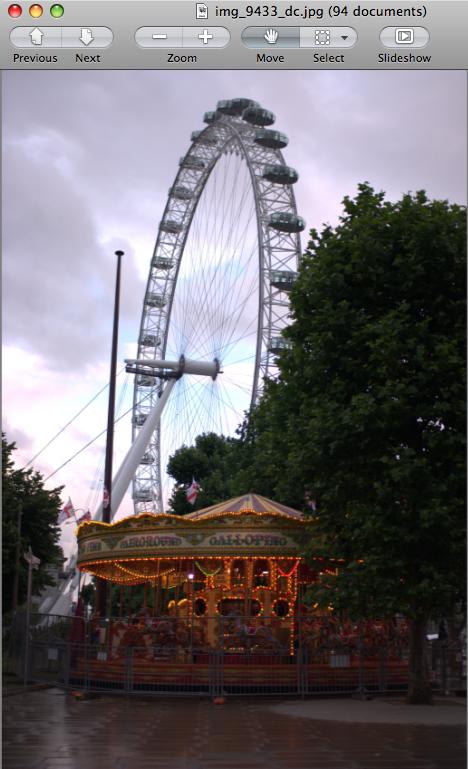
Notice the difference? Here are details of the displayed images, blown up 4x: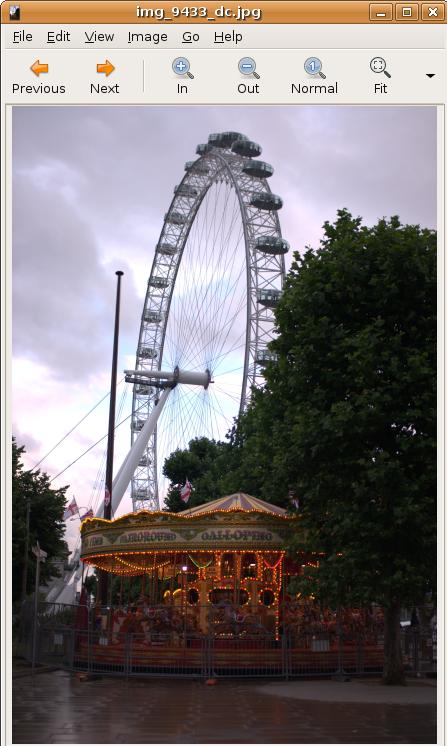
It appears that the blur issue is well known, though not something Apple seem interested in addressing. Presumably in Apple's official worldview, those working with photos who wish to see them without blur should be importing them into iPhoto or Aperture, and managing them with that.
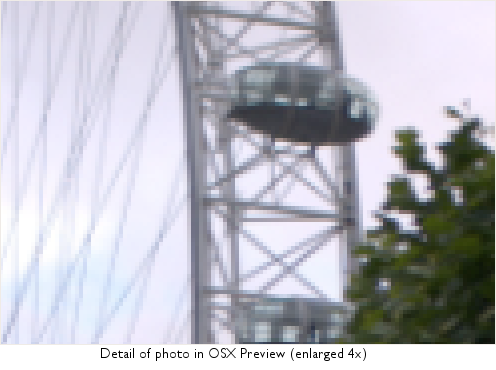
The only workaround given is to copy the version of Preview from an OSX 10.4 machine, modify its version information to run on OSX, and use that. Which, quite frankly, is not good enough.
2008/7/11
In an attempt to combat the more-megapixels-is-better delusion, the popular camera review site Digital Photography Review has added a new statistic to its camera specification databases: pixel density:
Pixel Density is a calculation of the number of pixels on a sensor, divided by the imaging area of that sensor. It can be used to understand how closely packed a sensor is and helps when comparing two cameras with different sensor sizes or numbers of photosites (pixels). Because the light collecting area and efficiency of each photosite will vary between technologies and manufacturers, Pixel Density should not be used as an absolute metric for camera quality but instead to get an impression for how tightly packed the imaging chip is.Tellingly, looking at the specs of the compact cameras I've owned, pixel density is one thing that's only getting worse. My current compact, a Canon PowerShot A570IS, clocks in at 29 MP/cm2, considerably behind its predecessor, a PowerShot A620 (19MP/cm2). Though it still does better than its immediate successor (with 32), and even Canon's high-end compact, the PowerShot G9, gets a marginally better 28. In contrast, my venerable old four-megapixel PowerShot G2 got 10 MP/cm2—which is almost in the DSLR ballpark—and it showed in the dynamic range and colour reproduction. Granted, it didn't fit into a pocket (unless one was wearing a large overcoat), but the photos did look good...
Hopefully the megapixel race-to-the-bottom will soon end as the public becomes aware of the fact that there is such a thing as pixel density and that it affects photo quality. Then maybe we'll see a new crop of 6-megapixel compacts, and a public that's aware that they actually take better pictures than higher-density ones.
(via ![]() reddragdiva) ¶ 0
reddragdiva) ¶ 0
2008/3/23
The practice of street photography, taking spontaneous photographs in public places, is under threat, as photographers find themselves lumped in with the shadowy paedoterrorist hordes who are out to kill us all and molest our children:
In the past year, the photography blogs have buzzed with tales of harassment, even violence. There's the war photographer who dodged bullets abroad only to be beaten up in his own South London backyard by a paranoid parent who (wrongly) thought his child was being photographed. There's the amateur photographer punched prostrate in the London Tube after refusing to give up his film to a stranger; the case of the man in Hull, swooped on by police after taking photographs in a shopping centre. “Any person who appears to be taking photos in a covert manner should expect to be stopped and spoken to by police ...” ran the Humberside force's statement.
Sophie Howarth is a curator specialising in street photography. She says she's noticed - despite the difficulties - a boom for the art, enabled by technology, and with London at the centre. “In France, traditionally one of the great centres of street photography, the law now says you own the rights to your own image, so street photography's become a dead art. In London there's a growing community of photographers, using digi- tal technology, not just cameras, but blogs, too, to document the city and give each other instant feedback.”When did the law in France change? Was that one of Sarkozy's neo-Galambosian intellectual-property-maximalist reforms, like pushing for EU-wide copyright term extension?
“I'm not going to belittle the issue of terrorism, but this is paranoia. And unfortunately, since Lady Di and now this link with terrorists, photography's seen by many people as something that's a little ... cheap.”
(via meimaimaggio) ¶ 0
2008/3/20
The Independent has an article on the extraordinary revival of the Holga, a cheap and primitive medium-format film camera made in China in the 1960s, now prized by lo-fi aficionados and art-school hipsters alike, much like the Lomo and Diana:
The Holga, barely more sophisticated than a pinhole camera, takes rolls of medium-format film which, when developed, produces square pictures. It features just two aperture settings ("sunny" or "cloudy"), four focus positions from "portrait" to "landscape", and a basic flash powered by AA batteries. A spring connects a clunky lever beside the lens to the shutter, which has just one speed (one-hundredth of a second – or thereabouts).
Williamson, 25, soon grew tired of what he calls the "sterility" of digital. In the age of the booming digital camera industry, with its spiralling megapixel counts and camera menus that would flummox a fighter pilot, converts to the cult of Holga celebrate the camera as an antidote to high technology. "Everything seemed so pristine in my photos," Williamson says. "They were almost optically perfect."
Williamson's website offers instructions on how to make the camera even more low-tech. Holga hackers can cut a square from a drink can, drill a hole in it with a sewing needle, unscrew the camera's shutter mechanism, insert the aluminium square in place of the lens, add a cable release to allow steady shooting, and voilà – you have a pinhole camera, christened, inevitably, the PinHolga.
2008/1/25
Art hipsters rejoice: someone has finally designed a digital camera without a screen or viewfinder:
Designer Sungwoo Park's prototype Eazzzy! camera consists of a USB stick with a lens and one button, and offers "the feeling of not knowing how your shots turned out à la analog film" with the convenience of USB transfer; not to mention a groovily ironic, retro-styled shape in several bright colours. And you can undoubtedly expect the images to turn out fashionably lo-fi, as you'd get that with anything of that size.

Though I wonder if it'd be just standard cameraphone lo-fi or whether they'd put an artfully crappy lens on the thing (as with cult film cameras such as the Lomo and Diana). They could, of course, program the firmware to oversaturate the colours, or overexpose the centre of the image and vignette the edges, though that would run against the cult of authenticity from which the lo-fi fad stems, thus being the photographic equivalent of alternative rock recorded for major labels in expensive studios, with special ProTools plug-ins thrown in to make it sound grungier.)
2007/12/24
Best picture quality with 6 megapixel!, or an assertion that, as the number of pixels in a compact camera increases beyond 6 million, the image quality decreases; the finer pixels have lower sensitivity and dynamic range, and thus are more susceptible to noise, while suppressing the noise algorithmically results in loss of actual picture resolution. Of course, the clueless masses, who don't like to think about these things, have been conditioned to equate higher numbers of megapixels with better quality, and will thus happily shell out more money for cameras with poorer image quality and the assurance that they are actually better because the files they produce are bigger.
2007/8/9
This is pretty impressive; a new algorithm that, when presented with a photograph with a hole cut out of it, searches a database of millions of other photographs, presents the user with a menu of similar-looking images to select from, and then composites elements of the chosen image to fill the hole seamlessly, producing an image which (in most cases) looks semantically coherent. Most impressively, it is entirely data-driven, and does not require any human-generated annotations of test data:
It uses mathematical properties of the images to make the match, and sometimes ends up serendipitously picking other images from the same location (because two photographs of, say, the Taj Mahal taken on a sunny mid-afternoon are likely to share similar properties).
Of course, it is possible to use such a tool creatively, replacing unwanted parts of an image with elements from a completely different scene, as the paper (PDF here shows:
2007/7/4
This guy attached a digital camera (a specially modified keychain camera) to his cat's collar and recorded the sequences of images as the cat (named Mr. Lee) went about his daily journeys. The images vary in quality (as one might expect), and include a lot of obscure nooks and crannies of the sorts cats frequent, and quite a few meetings with other neighbourhood cats.
The author of the page, J. Perthold, also sells cat-mountable digital cameras of his design for people who want to photograph what their cats are seeing. The next step, I imagine, would be to integrate wireless networking capabilities of some sort into the unit and set up a catlog.
2007/4/20
 Scientists at Mitsubishi have developed a camera which allows photos to be refocussed after being taken. Unlike previous experiments in this field, this system retains the full resolution of the camera's image sensor in the resulting image. It uses a special lens with a semi-transparent patterned mask (resembling a crossword puzzle) in the middle:
Scientists at Mitsubishi have developed a camera which allows photos to be refocussed after being taken. Unlike previous experiments in this field, this system retains the full resolution of the camera's image sensor in the resulting image. It uses a special lens with a semi-transparent patterned mask (resembling a crossword puzzle) in the middle:
Using the combination of the mask and the post-processing software, MERL researchers were able to reconstruct a 4D light field from the standard 2D camera, explained MERL Visiting Scientist Amit Agrawal. Instead of bending light rays, the patterned mask attenuates the rays inside the camera. The post-processing software reconstructs the light field using an inverse computation of the Fourier transform equation, allowing the user to refocus the image.The article has a slideshow, including some sample images. For some reason, they seem a bit dull, a bit like the images taken with digital cameras from 10 years ago; I wonder whether this is a result of the image reconstruction algorithm.
2006/9/19
Hewlett-Packard is doing its part to tackle the affluent world's obesity crisis—by developing a digital camera that can make photographic subjects look slimmer.
(via Boing Boing) ¶ 0
2006/9/15
Canon have just announced the PowerShot G7. The latest in Canon's top-end "G" series of compact cameras, the G7 is smaller than its predecessors (it's about the size of an A-series camera), features 10 megapixels, gyroscopic image stabilisation, sensitivity up to ISO 1600, and a new DIGIC III image processor. Gone, however, are the fold-out LCD screen (which was convenient for shooting over crowds, for example), and the RAW mode (which, presumably, is for DSLRs only these days).
Given its small size, I have some doubts over the image quality, in particular the dynamic range. I have a PowerShot A620, and have found that, when shooting images with ranges of colour, often the image quality is flat and washed-out, in a way that it wasn't with my old PowerShot G2. If this is due to the physical constraints of the sensor size, then unless Canon have since had a breakthrough in sensor engineering, it is unlikely that the new top-of-the-range G series will deliver any better performance than a humble A. I'd have to see results before I'm convinced that the G7 is a worthy successor to earlier G cameras.
Having said that, it sounds like a very good camera for shooting at gigs and such, having both IS and ISO 1600 (and the whole thing costing less than half the price of a good IS zoom lens for a DSLR.
2006/9/5
Apparently it's possible to modify a digital camera to take infrared photographs, by removing the infrared filter and replacing it with one that blocks out everything but infrared (made from material obtainable from photographic retailers). It's not recommended that you do this to any camera you'd mind destroying if the procedure fails, but if you are successful, you get something that takes photos like these:
2006/7/22
Tourist Remover is an online photo utility which, when given several photos of a scene, creates a composite photo containing only what appears in all the photos. I.e., if you give it several photos of a busy scene, thanks to the magic of image analysis, it'll give you an eerily empty scene from that point of view.
(via Boing Boing) ¶ 0
2006/6/7
John C. Dvorak takes a break from speculating about Apple and Microsoft to look at how strange our world would look to someone from the 1920s:
Let me begin with the one new commonplace practice that has less to do with technology than with legislation. And that's the crowd of people huddled in a group outside a building smoking cigarettes. This would have to be a weird sight for people from 1920. We don't think much about it, but it is indeed a weird sight.
Perhaps the weirdest societal change has to do with digital cameras and the practice of framing shots in the preview window by holding the camera out in front of yourself. Even ten years ago, nobody would have predicted that most people would now take pictures this way. Give people a pro digital SLR camera and they will still hold the thing in front of them at arm's length.(Are there digital SLRs that display a preview of the scene on the LCD screen in real time? My Canon EOS doesn't do that. I thought the whole point of an SLR is to require the photographer to look through the viewfinder, thus reinforcing their perception that they're a Real Photographer following a weighty and time-honoured tradition and standing on the shoulders of giants like Ansel Adams, rather than a mere amateur playing ignorantly around with a shiny, instantly-gratifying toy.)
Would anyone even 20 years ago have predicted that on every business card you will now find a standardized e-mail address? It's now deemed weird if you do not have an e-mail address on the card and have to write it on.All these things and others he mentions (mobile phones/BlackBerries, chatrooms, and so on) would seem utterly alien to someone from the 1920s (though I wonder whether any futurists or science-fiction writers from those times have predicted anything that comes close to the mark). When you think about it, some of them would seem quite odd to someone who had been asleep for a quarter of a century. One thinks of the 1980s, for example, as the recent past (after all, they had Madonna and Michael Jackson) rather than the Past proper, that foreign country (as L.P. Hartley put it) where they do things differently. Though someone who just woke up from having been in a coma since 1981 would find themselves in a different world: lacking a lot of little things they took for granted (like being able to smoke in offices, or on aeroplanes) and having a bunch of new, alien innovations (the internet and mobile phones, and the profound changes in social and cultural dynamics they have brought about, would be the big ones). To our 1981 exile, our mundane technology would seem slightly science-fictional: from our tiny, feature-packed DVD recorders and MP3 players (does anyone remember how huge early video recorders were?) to communications devices like something out of Star Trek, 2006 would look like scifi, only without the silver lamé jumpsuits and flying cars and other stylistic conventions that say "this is the (space-)future".
The iPods people listen to would seem familiar enough to our visitor, like a more advanced Walkman; what they'd make of the mainstream pop music of today, infused with influences from everything from hip-hop (a fringe scene in 1981, well below the radar) to dance-music genres driven by recent technology, is another matter. If the iPod in question was playing one of the various retro-styled acts popular today, from Gang Of Four/XTC-quoting new-wave-indie-art-rock bands to the last Madonna album, they may find it slightly familiar, though all the more unsettling in the subtle differences that betray it as of 2006, and made for a 2006 audience.
What if someone from 1991 arrived in 2006, with no awareness of the last 15 years? The shock would be somewhat lesser (though, in some ways, perhaps greater; the current age of homeland security and perpetual war against sinister shadows could be more of a rude awakening from the post-Berlin-Wall optimism of the 1990s than from the age of Mutual Assured Destruction). Email addresses on business cards would still seem a bit odd, though if our visitor was an academic or scientist, they would be familiar with them, and one could just about imagine the current state of the world leading to 2006, with its web-based commerce and pocket-sized, ubiquitous mobile phones. Though digital cameras could still seem strange.
In other words, the immediate past is a different neighbourhood; they do things slightly differently there. Go far enough and people start speaking a different language, though if you do so a day at a time, you won't notice the changes.
I wonder how strange 2016, or 2031, would seem to someone from now.
2006/4/24
An art gallery in London is having an exhibition of photographs by an outsider artist whose work has been making waves recently. Miroslav Tichý studied art in Czechoslovakia until the Communist authorities took objection to him being "different" and arrested him for subversion; he then spent some eight years in prisons and prison camps. Upon his release, a broken man with little hope for the future, he nonetheless pursued his artistic obsessions, fashioning crude cameras from junk and using them to take surreptitious photographs of women:
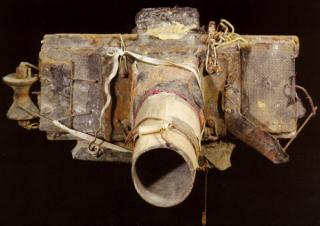
Upon his release in the early 70s, Tichý wandered his small town in rags, pursuing his obsession as an artist with the female form by photographing in the streets, shops and parks with cameras he made from tin cans, childrens spectacle lenses and other junk he found on the street. He would return home each day to make prints on equally primitive equipment, making only one print from the negatives he selected.
He stole intimate glimpses of his subjects through windows and the fences of swimming pools as well as in the streets, sometimes finding himself in trouble with the police. He would often draw intricately on each print in pencil embellishing the images with his lines or reworking them in other ways, Tichý would also sometimes include a card frame around the prints and decorate those too.
The work which might to the casual viewer, simply appear to be intrusive voyeurism, takes on a melancholic and poetic quality. They are exquisitely produced small objects of obsession, which have no equal. He produced work - not for others, but solely for himself without any regard for exhibiting or selling the work to others.
(via Boing Boing) ¶ 0
2006/4/23
Researchers at Binghamton University have developed a method of identifying the digital camera that took a particular image by isolating the unique noise fingerprint of the camera's sensor:
In preliminary tests, Fridrich's lab analyzed 2,700 pictures taken by nine digital cameras and with 100 percent accuracy linked individual images with the camera that took them.The researchers are promoting the development as a tool for catching and prosecuting child pornographers, though it could have other applications. For example, had the British government a database of the fingerprints of all digital cameras sold in the UK, correlated to the ID card numbers of the purchasers, they could quite easily arrest underground artists such as Banksy just by analysing the images on their web sites. During the Cold War, the KGB and East German Stasi had copies of all the letters typed on each typewriter in the country, so they could identify which typewriter a piece of samizdat came from. It is not inconceivable, in the Homeland Security Age, that an agreement will be worked out with camera manufacturers to supply the government with sensor fingerprint data (which could be taken in the factory during the testing phase) correlated with serial numbers; then all that would be necessary would be a law requiring camera purchases to be registered against identification. (In Australia, where you have to show ID for sending mail overseas, and where everyone is too relaxed and laid-back to care about civil liberties, such a law would sail through Parliament with bipartisan support and next to no debate; in Britain, those pesky Lords would probably cause trouble, for a while, at least.)
Of course, as Ars Technica states, it will only be a matter of time before software exists for removing or obfuscating camera fingerprints, or indeed for adding someone else's fingerprint to an image, rendering the process somewhat less than useful.
2006/3/8
Following up from yesterday's post about the digital camera/Lomo hybrid, and its question about digitally simulating the look of Lomo photographs: Alec Muffett has pointed me to a Kottke blog piece on the subject, which also links to this Photoshop-specific tutorial. For the penguinheads in the audience, there is a Gimp Script-Fu script for applying the Lomo effect here. Now you too can make the output of your high-end digital camera look "authentically" lo-fi.
2006/3/7
This person is attempting to build a homemade digital Lomo camera, by grafting a Lomo lens onto a camera (an Epson Digital Rangefinder, which sounds a bit too expensive to be something to casually hack). It'd be interesting to see whether he succeeds, and whether the resulting Frankensteinian hybrid really does combine the grungy, ultra-hip Lomo look with the convenience of digital.
If there was a market for a digital camera that takes pictures that look Lomo-like, wouldn't the obvious way to do it be by adding a mode in the onboard firmware which vignettes the edges of the image and fiddles the colours? I wonder whether anyone has written a Photoshop/Gimp plug-in which "Lomo-fies" images.
2006/2/5
A look at upcoming trends in digital cameras. The megapixel race, it seems, is over, with most people being happy with somewhere around 8; now attention has turned to image stabilisation, liquid lens technology and even more exotic advancements:
Some of Nikon's CoolPix models already contain face-recognition software, a feature that supposedly assists focus by scanning the scene for human facial features. And Canon is working on even more sophisticated recognition software. One, called Blink Shot, would prevent the camera from taking the picture when your subject's eyes are closed. A companion feature, called Smile Shot, waits to fire until your subject manages a grin.
2005/12/13
There is now a 39-megapixel digital camera on the market. You read that right; 39 megapixels, which would be about 7,212 by 5,408 pixels. The Phase One P45 can also boast a maximum frame rate of 35 frames per second; whether you'd end up using it is another matter, as its image files, weighing in at 117Mb, would pretty quickly fill up even the largest CompactFlash card. Though the existence of cameras of such a high resolution should bring light field photography somewhat closer to practicality.
I wonder what its dynamic range, thermal noise resistance and low-light performance are like, though; the smaller the pixels are on a CCD, the less sensitive to light they would theoretically tend to be.
2005/12/6
In Japan, they now have telephoto and wide-angle lenses for cameraphones. The lenses attach magnetically to give you new ways of taking crappy cameraphone photos, and cost ¥7000 (about £33, US$57 or A$77). More info here. There doesn't seem to be anywhere you can order these, at least without knowing Japanese.
(via bOING bOING) ¶ 0
2005/11/16
Scientists have developed a camera that takes pictures that can be refocussed afterward, by keeping track not only of the intensity of incoming light but of its angle as well.
Now, Pat Hanrahan and his team at Stanford University have figured out how to adjust the light rays after they have reached the camera. They inserted a sheet of 90,000 lenses, each just 125 micrometres across, between the camera's main lens and the image sensor. The angle of the light rays that strike each microlens is recorded, as well as the amount of light arriving along each ray. Software can then be used to adjust these values for each microlens to reconstruct what the image would have looked like if it had been properly focused. That also means any part of the image can be refocused - not just the main subject.The researchers' page on the "light field camera" includes papers and a gallery of refocusable images, and videos of focussing through a frozen moment. The examples look uncanny, as if splashes of water frozen in space were unbelievably intricate dioramas.
Applications of this technology include surveillance (where being able to change focus after the fact would often be useful) and motion photography; I imagine we may see this in films, music videos and ads soon enough as well.
2005/11/4
The latest instalment in the drawn-out death of film photography: veteran German photographic film company Agfa has declared bankruptcy, and is expected to stop operating by the end of the year.
Agfa has its origins in Germany in 1867 marketing its first colour film in 1936. Until Fuji became a market force, Agfa was the alternative to the dominant player, Kodak. Unlike Ilford, which has reacted to the change in photographic technology by using its paper-making expertise to move into the production of superior inkjet papers, Agfa appears to have misjudged the size and permanence of the digital tidal wave.In other words, someone at Agfa decided that digital photography was just a passing fad or a niche interest. Oops!
2005/2/24
Since buying a decent digital camera in 2002, I have taken a lot of photos (more than 7,000, including ones immediately deleted; those kept are probably a little over half of that). Recently, I found myself going through my collection, and started assembling some of the better ones I took in Melbourne between August 2002 and August 2004 (when I left for the UK) into a set of themed galleries.
These galleries are now online. There are a few themed galleries, consisting of the best ones fitting into a certain category (i.e., photos involving water, light (as a featured element), skies, graffiti/stencil/paste-up art and miscellaneous scenes from North Fitzroy), while others are sets taken together in one place and time.
2004/7/21
It appears that the recent panic about cameraphones happened 116 years earlier, when Kodak released the first portable camera:
The appearance of Eastman's cameras was so sudden and so pervasive that the reaction in some quarters was fear. A figure called the "camera fiend" began to appear at beach resorts, prowling the premises until he could catch female bathers unawares. One resort felt the trend so heavily that it posted a notice: "PEOPLE ARE FORBIDDEN TO USE THEIR KODAKS ON THE BEACH." Other locations were no safer. For a time, Kodak cameras were banned from the Washington Monument. The "Hartford Courant" sounded the alarm as well, declaring that "the sedate citizen can't indulge in any hilariousness without the risk of being caught in the act and having his photograph passed around among his Sunday School children."
Given the recent prohibitions on photography at railway stations from the New York Subway to the City Loop in Melbourne (undoubtedly to make people feel that something's being done to fight terrorism or somesuch), it appears that the "camera fiend" never really left the public demonology.
2004/5/27
2003/5/13
Adam Casey (of Seascapes of the Interior fame) just pointed me to this: The Secret Books, which appears to be a photographic art/coffee-table book inspired by Jorge Luis Borges. Some very nice photographs there; reminiscent of Dave McKean's found-object collages, or perhaps Joseph Cornell's boxes.
2003/1/2
Top Ten Digital Photography Tips; something to keep in mind for when I get my camera back from the repair place. (via Reenhead)
2002/8/7
2002/8/2
Nifty photographic technique of the day: painting with light. It involves a completely darkened room, a very long exposure and shining a light over a very patient model. (via gimbo)
2000/10/18
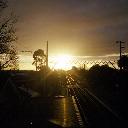 I just got back a roll of film I had sent in for processing. I took it to
a Kodak agent yesterday, and selected the "PictureCD" option (for $10 extra).
Consequently, with my prints, I got back a CD-R containing scans
(at a generous 1536x1024) of the photographs. The CD packaging lists
Windows or MacOS as requirements for viewing it, though my Linux machine
sees it as an ISO-9660 image containing .jpg files, which is good enough.
The Kodak PictureCD service gets a thumbs-up from me; having a CD-ROM of
JPEGs is a lot more convenient than an envelope of bits of paper.
I just got back a roll of film I had sent in for processing. I took it to
a Kodak agent yesterday, and selected the "PictureCD" option (for $10 extra).
Consequently, with my prints, I got back a CD-R containing scans
(at a generous 1536x1024) of the photographs. The CD packaging lists
Windows or MacOS as requirements for viewing it, though my Linux machine
sees it as an ISO-9660 image containing .jpg files, which is good enough.
The Kodak PictureCD service gets a thumbs-up from me; having a CD-ROM of
JPEGs is a lot more convenient than an envelope of bits of paper.
2000/7/30
Shutterbug Follies, a pretty nice web comic about a girl who works in a photo developing shop, and some of the things she sees. (via bOING bOING) (I once met someone who worked in such a shop; she saw a lot of amateur pornography, of varying degrees of twistedness, from customers who mostly believed that no-one looks at the photos. Then again, she worked in Prahran.)
